Blue tongue skinks make good pets, YES. But have you ever known how long blue tongue skink lives?
Blue tongue skink lifespan is one of the longest when it comes to gecko lifespan. In which case as a breeder, you should be prepared for a commitment of at least 20 years.
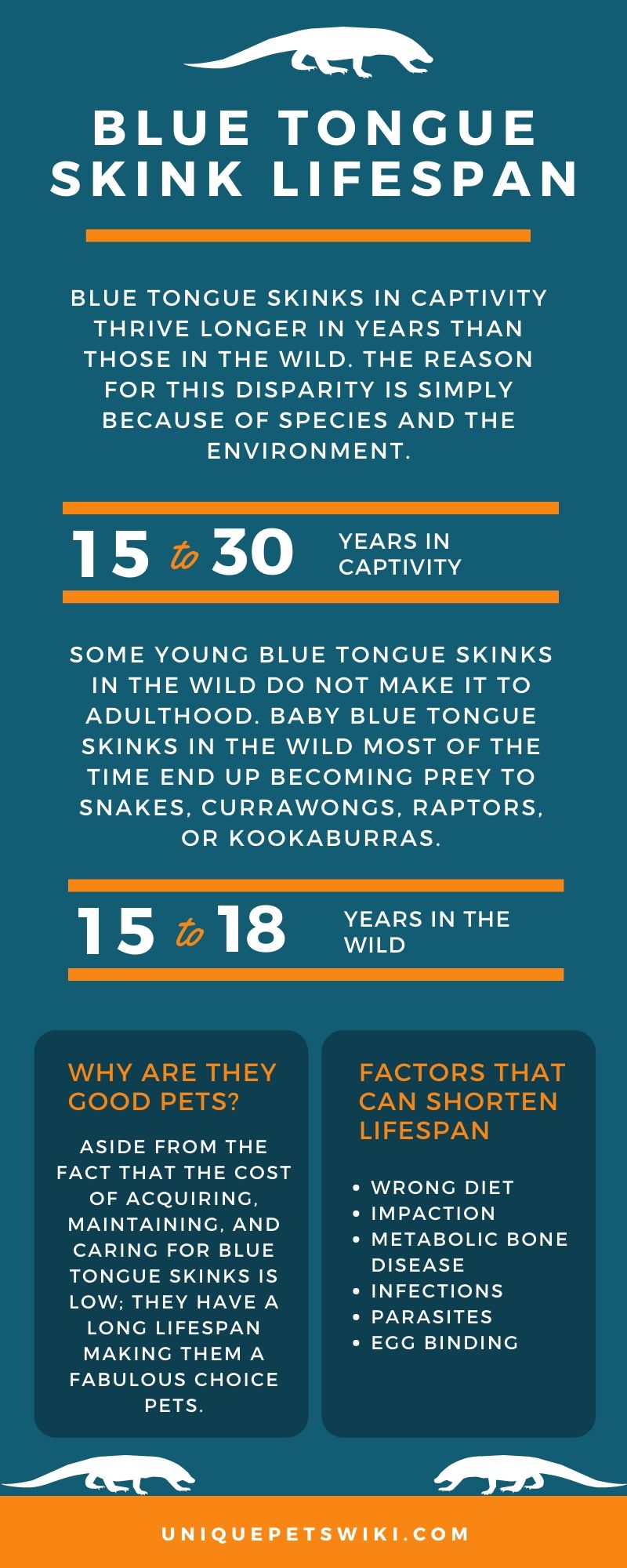
Contents
- How Long Can Blue Tongue Skinks Live In Captivity?
- The Case Of Blue Tongue Skinks – (Why Blue Tongue Skinks Make Good Pets)
- Blue Tongue Skink Lifespan In The Wild
- Factors That Can Shorten Your Blue Tongue Skink Lifespan
- 1.) Wrong Diet In Young Blue Tongue Skinks
- Foods To Feed Your Skinks
- Best Greens, Vegetables, Proteins And Fruits
- Foods You Should Not Feed Your Skinks
- 2.) Impaction In Blue Tongue Skinks
- 3.) Metabolic Bone Disease (MBD)
- 4.) Infections In Blue Tongue Skinks
- Respiratory Infection
- 5.) Parasites In Blue Tongue Skinks
- 6.) Egg Binding In Blue Tongue Skinks
- 7.) Eyes Problem In Blue Tongue Skinks
- Do Blue Tongue Skinks Have Vitamins Issues?
- Final Note
How Long Can Blue Tongue Skinks Live In Captivity?
Blue tongue skinks in captivity thrive longer in years than those in the wild. The reason for this disparity is simply because of species and the environment.
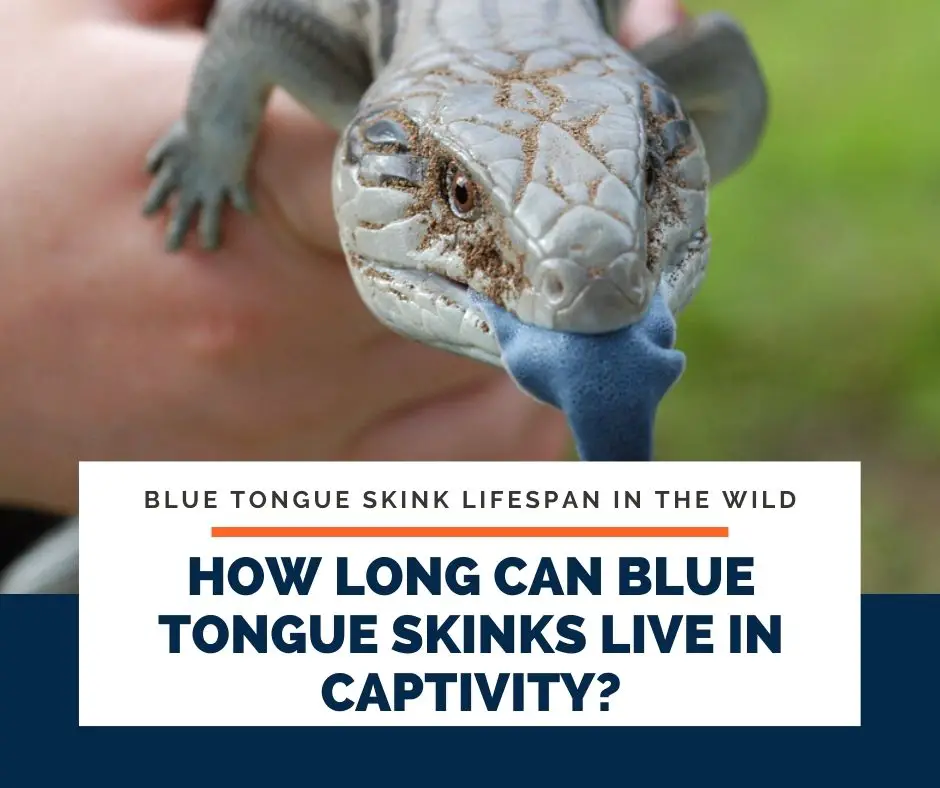
In the wild, blue tongue skinks have a lifespan of 15-18years, while in captivity they have a lifespan of 15-30 years or more. On average, with good care, a healthy blue tongue skink will live up to 20 years.
However, captive blue tongue skinks can live below the average life expectancy if their health is compromised by some factors such as wrong dieting, diseases, infections, parasite attacks, etc. These factors will be elaborated in subsequent sections.
The Case Of Blue Tongue Skinks – (Why Blue Tongue Skinks Make Good Pets)
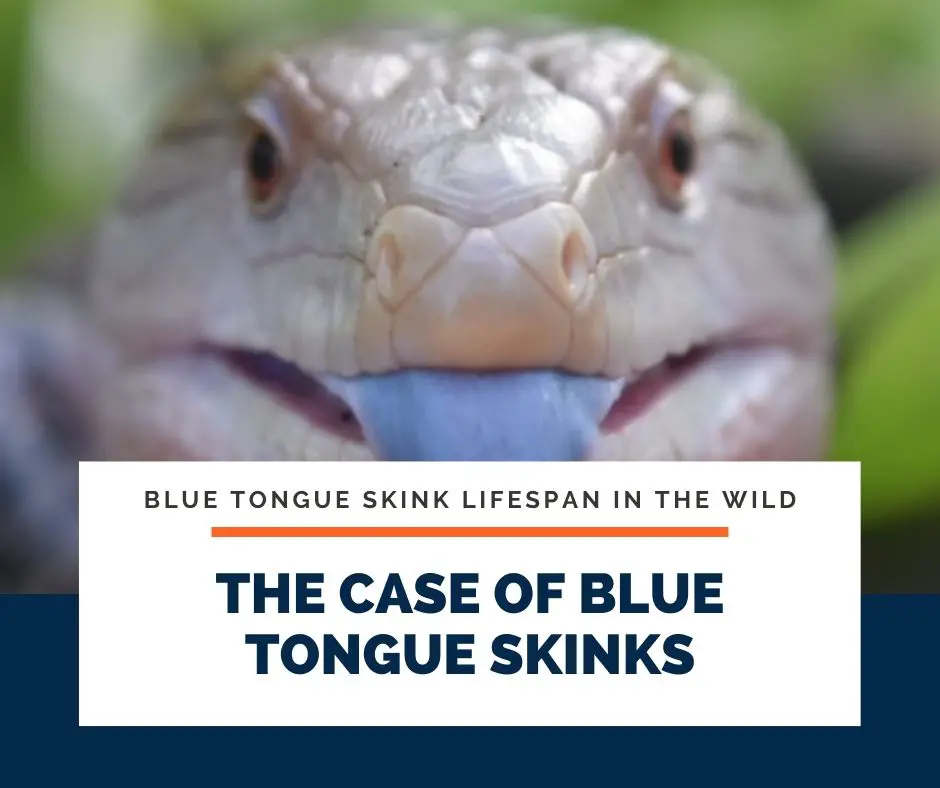
Blue tongue skinks are reclusive creatures, diurnal in nature, and practically compliant pets showing less aggression. But they tend to bite and hold tightly to the skin with their teeth especially when threatened.
Their bites however, is not something to get frightened of because it is not poisonous. They make great pets to both adults and kids because they are sizable to hold.
Aside from the fact that the cost of acquiring, maintaining, and caring for blue tongue skinks is low; they have a long lifespan making them a fabulous choice pets. But to be a good breeder and take good care of them, you will need adequate education on their needs.
Blue Tongue Skink Lifespan In The Wild
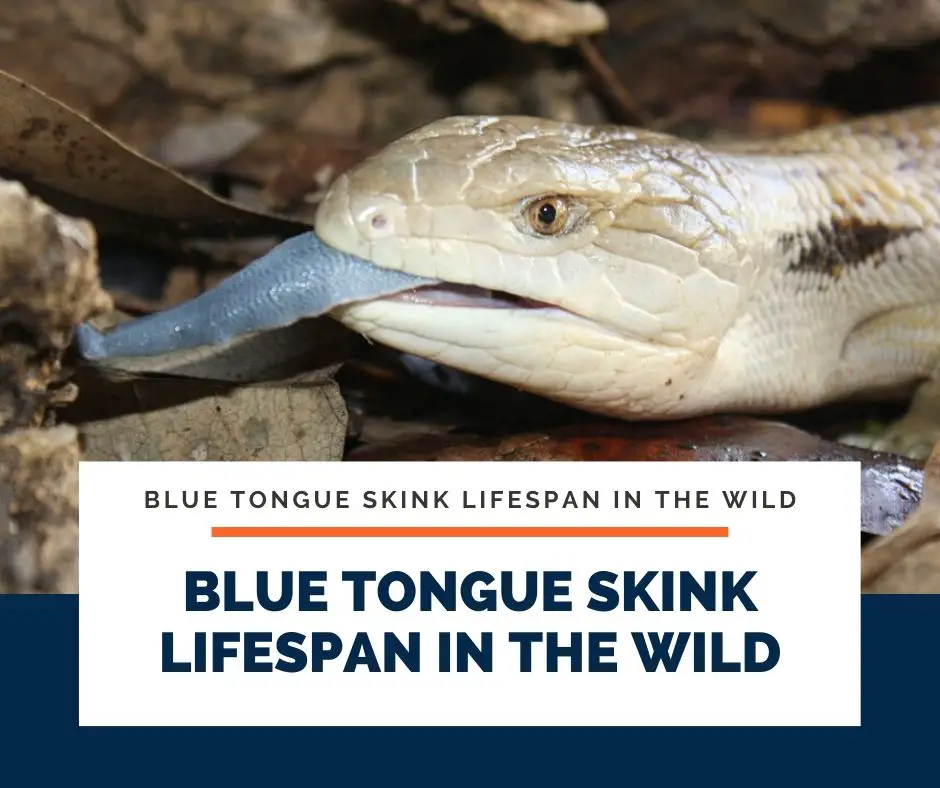
Due to the natural environment, blue tongue skinks in the wild live for fewer years than their counterparts in captivity. Some young blue tongue skinks in the wild do not make it to adulthood.
Since they are floor dwelling animals, they are vulnerable to a host of predators even with their defense mechanism of sticking out their bright-blue colored tongue.
Coupled with the fact that they aren’t fast-moving animals, their chances of escaping a deadly or fast-moving predator is slim.
Baby blue tongue skinks in the wild most of the time end up becoming prey to snakes, currawongs, raptors, or kookaburras.
As a survival technique in life-threatening cases, blue tongue skinks in the wild will drop their tails to escape a predator. In no long time the remaining tail will heal off and a new tail will grow.
With a steady food and water supply, It usually takes a period of 12 months for the new tail to fully revitalize.
Being that fat (food and water) is stored in their tails, once they lose their tails, without sufficient and stable food and water intake, they have nothing to fall back on. And in that case, they will die even before reaching full adulthood.
New to blue tongue skink? Check out the blue tongue skink care sheet now! We had listed out all the things you need to know about blue tongue skinks as pets. Check it now!
However, for skinks in captivity in the case of losing the tail, it’s easy to meet such needs and save their lives.
In summary, blue tongue skinks in the wild have a lifespan of 15 to 18 years. On average, a lucky blue tongue skink in the wild will live for 16years.
Factors That Can Shorten Your Blue Tongue Skink Lifespan
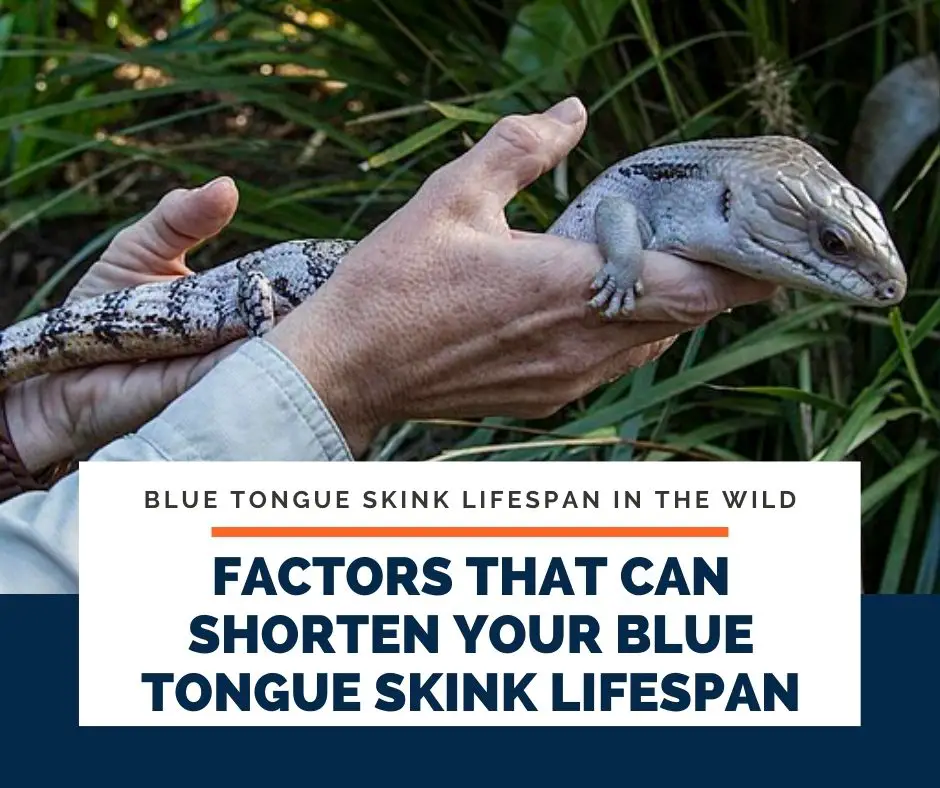
Some factors that can shorten the lifespan of blue tongue skinks as hinted in our opening paragraph will be explained in detail in this section. These factors are what can be prevented for blue tongue skinks in captivity. They include:
1.) Wrong Diet In Young Blue Tongue Skinks
A report by WHO in 2019 stated that “most of the chronic diseases and rapid decrease in life expectancy amongst humans are caused by wrong dieting and lifestyle”. The same thing applies to blue tongue skinks.
Wrong dieting does not only put your blue tongue skinks at risk of getting sick but may shorten their lifespan thereby leading to an untimely death.
The fact that they are omnivorous and can feed on a wide variety of greens, vegetables, animal proteins, and fruits does not automatically mean “feeding your skink with just anything”.
In the table below, you’ll find a detailed chart of what to feed your skinks in large quantities, what to feed in low quantities, and what NEVER to try on your skinks.
But before that, what is the right portion and proportion of food to be given to captive blue tongue skinks?
Blue tongue skinks less than 2years old should be fed 20%-30% of plants while skinks that are 2 years old should be fed 40%-50% of plants.
For animal protein, skinks less than 2 years should be given 70%-80% while those that are 2 years old should be fed 50%-60%.
Adult blue tongue skinks should be fed 50% vegetables, 40% animal proteins, and 10% fruits. The portion of each meal should be the size of the skink’s head with exception to baby and juvenile skinks.
Take note that the best time to offer food to your skinks is between 1-2 hours after they wake up. This will ensure proper digestion of the food in their system before they go back to sleep.
Foods To Feed Your Skinks
The table below contains a carefully selected list of foods that are nutritious and healthful to your skinks and will pose no health risk to them.
Foods in the last column are to be offered sparingly (probably once every 2 months). The reason is that they are either low in nutrients or high in goitrogens or contain oxalic acids; and as such should be given in small quantities.
Best Greens, Vegetables, Proteins And Fruits
A. Feed In Large Quantities
GREENS & VEGETABLES
Prickly pear cactus leaves, acorn squash, scallop squash, spaghetti squash, hubbard squash, mustard greens, escarole, collard greens, endive, arugula (rocket), mulberry leaves, hibiscus flowers and leaves, fresh alfalfa (not sprouts or dried), nasturtium flowers, dandelion squash, chicory greens, basil, rosemary oregano.
PROTEIN
crickets, mealworms, silkworms (one of the best), black soldier fly larvae (best, need no supplement), discoid roaches, ivory head roaches, orange head roaches, lobster roaches, locusts, Turkestan, tomato hornworms, dubia roaches.
FRUITS
Apple, cantaloupe, papaya, mangoes.
B. Feed Occasionally
GREENS & VEGETABLES
Kale, pinto beans, green beans, pumpkin, red or green or yellow bell pepper, parsnips, asparagus, snap peas (pods & peas), watercress, chayote, garbanzo.
PROTEIN
Cooked lean beef or goat meat – heart, ground lean turkey meat (cooked only),cat food, dog food, snails, raw or semi-cooked eggs, cooked chicken breast or heart, butterworms (high in fat), pinkies (fuzzy mice, neonate mice or rats).
FRUITS
Peaches, blackberries, guava, figs, apricot, honeydew, cranberries, blueberries.
C. Feed Rarely
GREENS & VEGETABLES
Okra, carrots, radishes, red or green cabbage, celery, parsley, cassava leaves, turnips, sweet and brown potatoes, lettuce of any type, brussel sprouts, cucumber, bok choy, yams, broccoli, beetroot, cauliflower, Swede, Swiss chard, kohlrabi, beet Greens.
FRUITS
Asian pears, peaches, cherries, Watermelon (too much will cause diarrhea), pomegranate (high in Phosphorus & can cause impaction), nectarine (high in Phosphorus), cherries (goitrogenic).
Foods You Should Not Feed Your Skinks
Foods listed below are foods you should avoid because they are highly toxic and lack nutrients for blue tongue skinks. If you should offer your skinks any of these foods, it should be once in a long while.
A. Food: Garlic, rhubarb, mushrooms, onions, aubergine, avocado, chives, fruits’ seeds (such as apple, apricot, cherry etc)
Reasons: Highly toxic
B. Food: Bananas, corn, tomatoes, pineapple.
Reasons: Acidic and high in Phosphorus
C. Food: Spinach, kiwis, star fruit.
Reasons: Very oxalic
D. Food: Citrus family (oranges, tangerines, lemons, grapefruit etc).
Reasons: Cause serious digestive problems
E. Food: Dried fruits such as prunes.
Reasons: High in sugar with low water content
F. Food: Green or purple grapes.
Reasons: Can cause kidney and liver problems
G. Food: Leeks
Reasons: Given in much quantity can cause anaemia.
H. Food: Potato plants, azalea, buttercup, primrose, red maple, honeysuckle, poison ivy, ris, daffodils, amaryllis, bracken fern, juniper, honeysuckle, oak, stinging nettle, nightshade (any plant), swiss cheese plant, eucalyptus, buckthorn, fireflies (lightning bugs).
I. Food: Lubber grasshoppers, monarch butterflies and caterpillars, ants (not all are toxic, but stings of some may cause allergic reactions), centipede (bites), spiders (bites), queen butterflies and caterpillars, scorpions, ladybugs, wasps (stings).
2.) Impaction In Blue Tongue Skinks
Impaction is a condition in which there is an internal blockage that prevents blue tongue skinks from pooping. This health concern is caused by loose substrate such as crushed walnut shell or sand, and overfeeding.
For blue tongue skinks in the wild, excessively large prey can cause impaction.
Symptoms of impaction include no poo, loss of appetite, lethargy, and partial paralysis in hind legs.
3.) Metabolic Bone Disease (MBD)
Metabolic bone disease is one of the most common diseases in reptiles that causes weakness of the bones. This is mostly due to lack of varieties in their diet (diet not rich in calcium), and the inability of skinks to properly absorb calcium from their diet.
Many fruits that can be given to blue tongue skinks are rich in Phosphorus and too much of Phosphorus in their system is harmful to their health.
That’s why offering a variety of foods and most times supplementing their diet with vitamins is very important.
Not getting enough UV rays also contributes to metabolic bone disease. This disease if left untreated will lead to stunted growth, weakness of bones, partial or full paralysis, lumps on the back and tail, and may lead to death.
Treatment/Prevention of MBD
Metabolic bone disease is best treated by a veterinarian. However, while on your visit to one, give your skinks a variety of foods using our food charts given above.
Ensure that the UV lighting for your skinks is sufficient and supplement their diet with calcium supplements especially calcium-fortified with vitamin D3 to help restore their vitamin D reserves.
4.) Infections In Blue Tongue Skinks
Infections are caused by bacteria, viruses, and fungi. They came as a result of poor hygiene or poor husbandry. The most common infectious diseases that can shorten the lifespan of blue tongue skinks are respiratory infection, scale rot, and mouth rot.
Respiratory Infection
This is a bacterial infection that affects the lungs causing difficulty breathing. Symptoms of respiratory infection include:
- Runny nose.
- Swollen and bloated body.
- Breathing difficulty (breathing with open mouth).
- Gasping for air.
- Lethargy.
- Scabbed lips.
- Weepy eyes.
- Weight loss.
- Loss of appetite.
- Slimy mucus-like discharge from the mouth and nose, and loud exhalation.
Mouth Rot
This disease is one of the most painful infectious diseases in blue tongue skinks that will inevitably lead to loss of appetite.
Mouth rot is caused by either bacteria or virus or fungi that makes the mouth inflamed to the point of tissues rotting.
Symptoms include excessive saliva or discharge from the mouth, inflamed or red oral tissues, decreased appetite or complete loss of interest in food, yellowish or grayish areas of skin around the mouth, dead tissue in or around the mouth, and swelling of the head (only visible in severe cases).
Scale Rot
This is a bacterial infection that causes the inflammation of the skin. It is usually due to poor husbandry.
Avoiding Infections
If your skinks are already suffering from any kind of infection, seek the necessary treatment from an experienced vet. To prevent a recurrence, up your care with these husbandry tips:
- Maintain accurate and stable temperatures in your skinks’ enclosures. Enclosures with high humidity levels give room for parasites, bacteria, and viruses to thrive.
- Ensure to clean their terrarium and enrichment accessories monthly using pet disinfectant.
- General cleanliness is the key.
5.) Parasites In Blue Tongue Skinks
Parasites that attack blue tongue skinks can be internal (tapeworm, roundworm, and lungworm) or external parasites (mites, ticks, etc).
Since parasites live and feed on their host, blue tongue skinks plagued with parasites are going to be robbed from the nutrients they need for survival.
Prolonged parasites infestation without adequate treatment reduces the lifespan of blue tongue skinks mostly in the wild.
Captive blue tongue skinks have better care and there is a high chance of being treated before it gets worse.
I advise you to read more for signs and symptoms of parasites; treatment and prevention.
6.) Egg Binding In Blue Tongue Skinks
Dystocia is what is referred to as egg binding or egg retention in reptiles. It is a health issue common to all species of female reptiles capable of laying eggs.
Egg binding in blue tongue skinks simply is the failure of the female blue tongue skink to either complete or reverse the reproductive process or the inability to pass out an egg that has been formed.
As a result, the formed egg (fetus) remained within the female reproductive system causing both physical and internal damage.
The damages caused by egg binding in blue tongue skinks if not early detected and treated can lead to infertility and even death. In the wild, egg binding is not commonly reported the way it affects skinks in captivity.
Causes Of Egg Binding
- The major cause is an injury to the pelvis or other disorders that narrow the pathway for eggs making it practically impossible for the egg to pass.
- Over large or malformed eggs.
- Egg that is not positioned correctly, or broken, or fractured (joined to other eggs).
- Malnutrition especially diets not rich in calcium.
- Poor condition of the mother such as weak muscles and MBD.
- Lack of exercise.
- Lack of suitable nesting sites. All blue tongue skinks need a private and quiet space in their enclosures with the correct temperatures, substrates, and depth for egg-laying.
- Obesity (large legs).
- Dehydration.
- Stress.
- Illness: diseases such as infections of the reproductive organs, dehydration, or kidney disease.
- Excessive breeding of the same animal may also result in egg binding.
New to blue tongue skink? Check out the blue tongue skink care sheet now! We had listed out all the things you need to know about blue tongue skinks as pets. Check it now!
Symptoms Of Egg Binding
Blue tongue skinks with egg binding usually show signs of depression, are inactive, and lethargic. They may also raise their hindquarters and strain without producing any eggs.
Egg binding is a serious condition that needs medical attention as soon as possible if not it can lead to death in a matter of a few days.
Treatment Of Egg Binding
There are four approaches to treating egg binding in female blue tongue skinks:
- Physical Manipulation: This involves gently massaging the egg out of the reproductive tract.
However, in situations where the affected skinks appear to be in good condition, providing them with a suitable nesting site in an adequately heated and humidified enclosure and leaving it undisturbed may be all that is required to stimulate the birthing process.
- Hormonal Stimulation: Hormone injections can be given to stimulate labor.
- Removal of the egg contents
- Surgical removal of the eggs: the eggs can be collapsed using a needle and syringe or a surgery can be carried out to remove eggs (in severe cases).
7.) Eyes Problem In Blue Tongue Skinks
Eye problems can shorten the lifespan of blue tongue skinks. It is due to a deficiency in “vitamin A”. Blue tongue skinks with prolonged deficiency in vitamin A will have abnormal skin coloration around the eyes and lips.
A typical food rich in vitamin A you can give to your skinks is carrot. However, from our food chat, carrots are to be offered sparingly. You can supplement their diet with vitamin A supplements.
Do Blue Tongue Skinks Have Vitamins Issues?
Yes, they do. Even with their wide variety of foods, blue tongue skinks suffer from vitamin deficiency much like humans and this is another factor that shortens their lifespan both in the wild and in captivity.
Vitamins are needed in their body for the building of tissues.
The common vitamin issues in blue tongue skinks are vitamin D3 and vitamin A deficiency. The significance of vitamin D3 is to help their body to absorb calcium from their diet.
A skink that is not provided with sufficient UV lighting (either naturally through the sun or artificially via quality UV bulbs) will suffer vitamin D3 deficiency.
The result of this deficiency is always metabolic bone disease as the body will be incapable of absorbing and retaining calcium.
Vitamin A deficiency is another most common vitamin issue in blue tongue skinks. This can lead to changes in skin color and some minor infections, particularly around the eyes and lips. This can lead to blindness.
Final Note
No matter how knowledgeable you think you are with the subjects of blue tongue skinks, you still need to read more on how to care for them. Length of time as a pet owner does not necessarily make you an expert or show how experienced you are.
As discussed in this article, being a great breeder entails diligence since they are long-lived. However, without proper care, you may lose your skinks even before they get to adulthood because of negligence or oversight.
The bottom line to providing good care to your skinks is, regularly examining your skinks and keeping the records to keep tabs on your skinks.
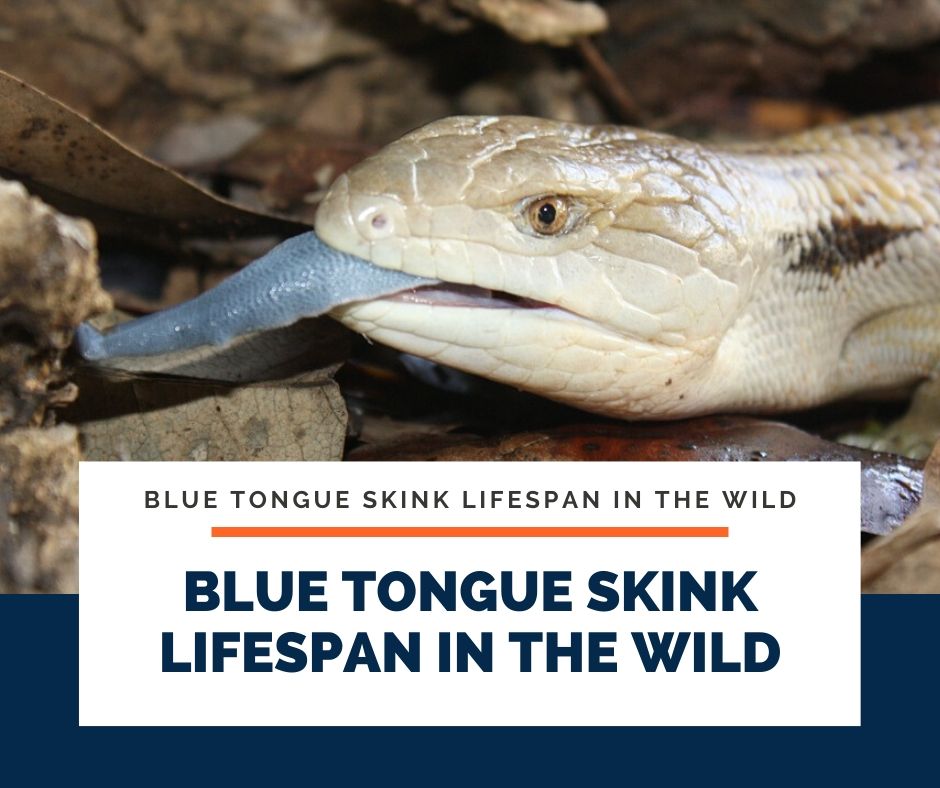
bravo for this